Alpacas
Just as the lamas, alpacas are part of the South American camelids group, but originate from the Vicugna, are a little bit smaller and significantly lighter than lamas. The easiest way to distinguish alpacas from lamas is by the shape of their ears: the ears of alpacas are formed like spears, a lama’s ears look more like a banana.
Already the Inca people highly estimated alpacas for their silky wool, so it is no surprise that it was the ruling family’s privilege to wear garments made of alpaca wool. When the Spanish conquered South America in the following, the alpacas were replaced by sheep and almost disappeared.
Today the alpaca is considered valuable once again, not only because of its precious wool but also for therapy including animals, as this nice creature approaches humans simply driven by its own curiosity.
Already the Inca people highly estimated alpacas for their silky wool, so it is no surprise that it was the ruling family’s privilege to wear garments made of alpaca wool. When the Spanish conquered South America in the following, the alpacas were replaced by sheep and almost disappeared.
Today the alpaca is considered valuable once again, not only because of its precious wool but also for therapy including animals, as this nice creature approaches humans simply driven by its own curiosity.

| Family | Camelidae |
| Order | Artiodactyla |
| Suborder | Tylopoda |
| Origin and distribution | Originally kept in herds on the level heights of the Andes of southern Peru, northern Bolivia, Ecuador and northern Chile; today Alpacas are bred almost all over the world |
| Habitat | High mountain pastures, steppe and veldt, semi-desert areas |
| Diet | Grass, shrubs, moss, lichen, hay, fresh and dry leaves |
| Behavior | Social herd animal |
| Life expectancy | Up to 20 years |
| Weight | 65 to 80 kg |
| Height at the withers | Up to 90 cm |
| Coat colors | Plain white, apricot, gray, brown and black; rarely spotted or appaloosa patterns |
| Breeds | Huacaya and Suri |
| Gestation period | 330-360 days |
| Foals | 1 per year |
| Characteristics | no hump; soft padded feet with two toes (Tylopoda); upper lip is split in two halves, pointed ears, soft fiber, furry head |




